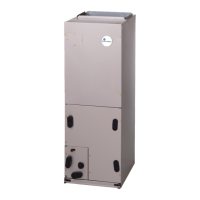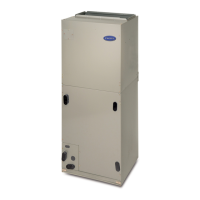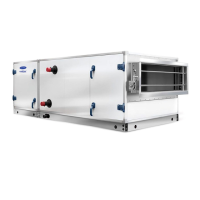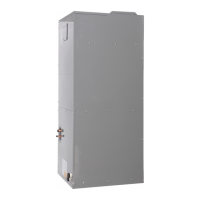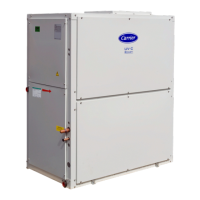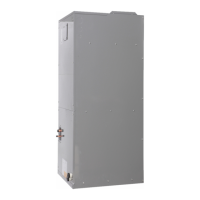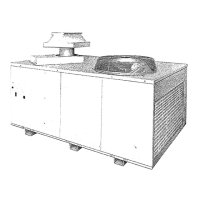106
DAYLIGHT SAVINGS STOP (DS.SP)
This submenu configures the end date and time for daylight
savings.
Daylight Savings Stop Month (DS.SP
SP.MN)
This is the stop month for daylight savings time. The numbers 1 to
12 correspond to the months of the year (e.g., January = 1).
Daylight Savings Stop Week (DS.SP
SP.WK)
This is the stop week of the month for daylight savings. The week
can be set from 1 to 5.
Daylight Savings Stop Day (DS.SP
SP.DY)
This is the stop day of the week for daylight savings. The day can
be set from 1 to 7 (Sunday=1, Monday=2, etc.).
Daylight Savings Minutes To Subtract (DS.SP
MIN.S)
This is the amount of time that will be removed from the time
clock after daylight savings ends.
TROUBLESHOOTING
The scrolling marquee display shows the actual operating condi-
tions of the unit while it is running. If there are alarms or there
have been alarms, they will be displayed in either the current
alarm list or the history alarm list. The Service Test mode allows
operation of the compressors, fans, and other components to be
checked while the unit is not operating.
Complete Unit Stoppage
There are several conditions that can cause the unit to not provide
heating or cooling. If an alarm that causes the unit to shut down is
active, diagnose the problem using the information provided in the
Alarms and Alerts section on page 122, but also check for the
following:
• Cooling and heating loads are satisfied.
• Programmed schedule.
• General power failure.
• Tripped control circuit transformers circuit breakers.
• Tripped compressor circuit breakers.
• Unit is turned off through the CCN network.
Single Circuit Stoppage
If a single circuit stops incorrectly, there are several possible caus-
es. The problem should be investigated using information from the
alarm and alert list.
Service Analysis
Detailed service analysis can be found in Tables 86-89 and
Fig. 16.
Restart Procedure
Before attempting to restart the machine, check the alarm list to
determine the cause of the shutdown. If a shutdown alarm for a
particular circuit has occurred, determine and correct the cause be-
fore allowing the unit to run under its own control again. When
there is a problem, the unit should be diagnosed in Service Test
mode. The alarms must be reset before the circuit can operate in
either Normal mode or Service Test mode.
Humidi-MiZer Troubleshooting
Use the unit scrolling marquee or a CCN device to view the sta-
tus display and the diagnostic display for information concerning
cooling operation with the Humidi-MiZer system. Check the
Current Alarms and Alarm History for any unresolved alarm
codes and correct. Verify Humidi-MiZer configuration settings
are correct for the site requirements. If alarm conditions are cor-
rected and cleared, then operation of the compressors, fans, and
Humidi-MiZer valves may be verified by using the Service Test
mode. See page 38. In addition to the Cooling Service Analysis
(Table 86), see the Humidi-MiZer Service Analysis (Table 87)
for more information.
Thermistor Troubleshooting
The OAT, SAT, RAT, CCT, T55, T56, and T58 temperature sen-
sors use 10K thermistors. Resistances at various temperatures are
listed in Tables 90 and 91. The DTT uses an 86K thermistor. See
Table 92. The RGTA uses a 5K thermistor. See Tables 93 and 94.
THERMISTOR/TEMPERATURE SENSOR CHECK
A high quality digital volt-ohmmeter is required to perform this
check.
1. With the unit powered down, remove the terminal strip of
the thermistor being diagnosed from the appropriate control
board (MBB-J8 or RCB-J6). Connect the digital ohmmeter
across the appropriate thermistor terminals in the terminal
strip.
2. Using the resistance reading obtained, read the sensor tem-
perature from the appropriate sensor table.
3. To check thermistor accuracy, measure the temperature at
the thermistor location with an accurate thermocouple–
type temperature measuring instrument. Insulate thermo-
couple to avoid ambient temperatures from influencing
reading. The temperature measured by the thermocouple
and the temperature determined from the thermistor resis-
tance reading should be within 5°F (3°C) if care was taken
in applying thermocouple and taking readings.
If a more accurate check is required, unit must be powered down
and thermistor removed and checked at a known temperature
(freezing point or boiling point of water) by measuring the resis-
tance of the thermistor with the terminal strip removed from the
control board. With the terminal strip plugged back into the con-
trol board and the unit powered up, compare the temperature de-
termined from the resistance measurement with the value dis-
played by the control in the Temperatures menu using the scrolling
marquee display.

